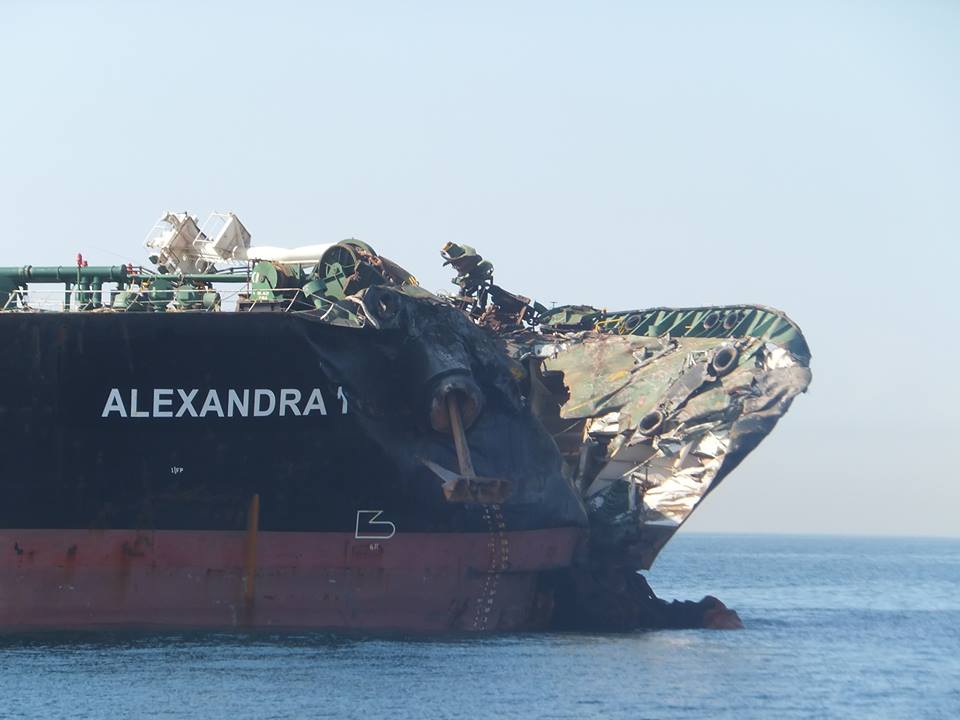

M/V “Ever Smart” in collision with VLCC “Alexandra 1” [2021]

Vessels crossing at the entrance to narrow channels – the COLREGS clarified by the English Supreme Court
In the first of two articles, we examine this important decision on its facts and in the second, the practical lessons to be learned.
It is commonplace for collisions to occur because the outbound ship is dropping her pilot for him to go to an inbound ship, bringing the ships into close proximity. This is one such case.
This rare collision decision by the Supreme Court determines the inter-relationship between the “crossing rules”, (rules 15-17 of the Collision Regulations (COLREGS) requiring the vessel which has the other on her starboard side to keep out of the way (the “give-way vessel”) whilst the other vessel is required to keep her course and speed (the “stand-on vessel”), and the narrow channel rule (rule 9(a)) requiring a vessel proceeding along a narrow channel to keep as near to its starboard outer limit as is safe and practicable.
The case has grappled with what might be seen as a tension between the obligations of a stand-on vessel to keep her course and speed and the obligation of that vessel to comply with some other rule.
The collision occurred between large container vessel Ever Smart (“ES”) and the VLCC Alexandra 1 (“A”) in the pilot boarding area, just outside the dredged channel to Jebel Ali. “A” was inbound and awaiting the pilot from “ES” before entering the channel which is a “narrow channel” for the purposes of the rules.
The Supreme Court produced a 60 page judgement including reference to authorities going back at least to 1886, long before the advent of radar, VHF, AIS, proper lit buoyage and Port State Control and a uniform version of the rules applied internationally. The earlier decisions concerned collision cases in and around narrow channels in the approaches to the ports of Buenos Aires, Cardiff, Cherbourg, Dakar, Grimsby, Hong Kong, Liverpool, London, Los Angeles, Mumbai, Nagoya, New York, Ras Tanura and Willemstad.
A VDR reconstruction of the ships’ tracks was agreed for the trial and is displayed below.
The facts in brief
It was dark, the visibility was good and the weather was fair. There was slight SW current.
The channel at Jebel Ali runs 135°/315°T and is slightly less than two cables wide. The seaward buoy is no.1.
At around 23:15 “A” was waiting about 1.4 miles WNW of No.1 buoy(s) having been told by Port Control that “ES” would proceed to No.1 buoy(s) where she would disembark her pilot who would then board “A”. Once “ES” was clear “A” was told that she “can enter the channel”.
At C-24 “A” had stopped engines, was making 2.3 kts, course made good (cmg) 126°, heading 110° and observed “ES” proceeding outbound in the channel (about 5 miles away).
At C-14 “A” misunderstood a conversation between Port Control and a tug to indicate that “ES” would pass 1 mile astern of “A”. This caused the master of “A” concern but he did not seek clarification. “A” continued approaching the channel very slowly.
At C-5 “A” was approaching the position where she would normally have altered course to starboard to line up with the starboard side of the channel but she did not do so because of her mistaken belief that “ES” was to pass under her stern.
At about C-2 “A” observed “ES” not turning to port as anticipated and “A”’s engines were put full astern. At C-30 seconds her engines were put to dead slow astern and she called “ES” and requested her to go hard to starboard and switched on her deck lights.
“ES” had meanwhile proceeded outbound, with a pilot aboard, at half ahead and then from C-10 at slow ahead but on the port side of the channel in breach of COLREGS Rule 9.
At C-9 the pilot advised the master that “A” was to port and to take care. “ES” was making 12.2 kts on 312°.
At C-6 the pilot was away having advised the master to make 10 kts on 314°, that there was a vessel to port and to take care.
At C-5 her speed was increased. She passed No. 1 buoys at C-2 and at collision she was making 12.4 kts.
At C-30 seconds Port Control and the pilot (still on the pilot boat) and “ES” called “A” and instructed her to go hard a starboard.
At C “A”’s bow was on about the centre line of the channel. The port bow of “ES” struck the starboard bow of “A”.
According to “ES”’s VDR, very shortly before the collision her master had remarked “Whats that” and less than two minutes after it he complained to his officer of the watch and helmsman “both of you…have you seen it or not?”…”How come you didn’t see it”.
At about C+ 6 the master of “A” reported to his owners “We hit her … because she stopped outside waiting, we were leaving the port, we did not see that … I saw the light, but didn’t know she was transverse, so we knock against her bow”.
The decisions of the Admiralty Judge at first instance and Court of Appeal
The Admiralty judge concluded that:
The crossing rules did not apply because “A’ was clearly waiting for a pilot and had not settled on a steady (“sufficiently defined”) course. It was held that if the crossing rules were engaged, they were overridden by the narrow channel rules. As such “A” was not under an obligation to stay out of the way of “ES”.
As to faults of “A”, she had approached too close to the end of the channel. The Elder Brethren advised the court that “Subject to a good aural and visual lookout, it would be reasonable and good seamanship for the master of Alexandra I to have approached the first pair of buoys keeping close to her own side of the entrance channel.” She had failed to keep a good aural lookout resulting in her failure to turn to starboard towards the channel and instead headed so as to cross the approaches.
As to ”ES”, she had failed to keep to the starboard side of the narrow channel in breach of the rules, maintained a defective radar and visual lookout and proceeded at an excessive speed.
“ES” was found to bear 80% of the blame and “A” 20%.
ES appealed on grounds, in effect, that these findings did not give sufficient weight to the fundamental importance of the crossing rules in preventing collisions at sea. However, the Court of Appeal upheld the decision of the Admiralty judge finding “that this was not a situation where it is necessary to apply the crossing rules to secure safe navigation – and if it is not necessary to apply the crossing rules it can be fairly said that it is necessary not to apply them, so as to avoid adding a layer of confusion”. The court accepted the advice of the nautical advisers that with a sharp lookout and application of the requirement of “good seamanship” (eg rules 2, 5, 6 and 7) together with rule 9 provided a comprehensive and realistic guide to safe navigation in these circumstances.
The Supreme Court
Leave to appeal again was granted. Two discrete issues accordingly fell by agreement between the litigants to be considered, on a proper construction of the COLREGS, by the Supreme Court:
1: Are the crossing rules inapplicable or should they be disapplied where an outbound vessel is navigating within a narrow channel and has a vessel on her port (or starboard) bow on a crossing course approaching the narrow channel with the intention of and in preparation for entering it?
2: Is there a requirement for the putative give-way vessel to be on a steady course before the crossing rules can be engaged?
The Supreme Court overturned the ruling in the courts below in relation to the application of the crossing rules and held that:
1: The crossing rules are overridden only when the approaching vessel is shaping to enter the channel, adjusting her course so as to reach the entrance on the starboard side of it, on her final approach. That can be determined from the vessel leaving the channel by visual (or radar) observation of the approaching vessel’s course and speed.
2: If two vessels are crossing so as to involve risk of collision, the engagement of the crossing rules is not dependent upon the give-way vessel being on a steady course. If it is reasonably apparent to those navigating the two vessels that they are approaching each other on a steady bearing then they are indeed crossing, so as to involve a risk of collision, even if the give-way vessel is on an erratic course.
On the facts, all the elements requiring the application of the crossing rules were present:
- Both vessels, being visible to each other, were moving
- Their bearings were readily measurable
- They could observe that they were approaching
- “A” had “ES” on her starboard side
- The bearings did not appreciably change (despite the changes of course of “A”)
- They were in fact crossing so as to involve a risk of collision
- “A” was the give way and “ES” was the stand-on vessel
In our second article we move on to consider the likely outcome on apportionment of liability and analyse the practical implications of the decision for mariners and fleet superintendents. We also point out circumstances in which there may be difficulties in applying the decision.
*Contribution by Martin Watson, Master Mariner solicitor
**This commentary represents the private opinions of the authors and is no substitute for detailed legal advice. All cases are highly fact dependent.

